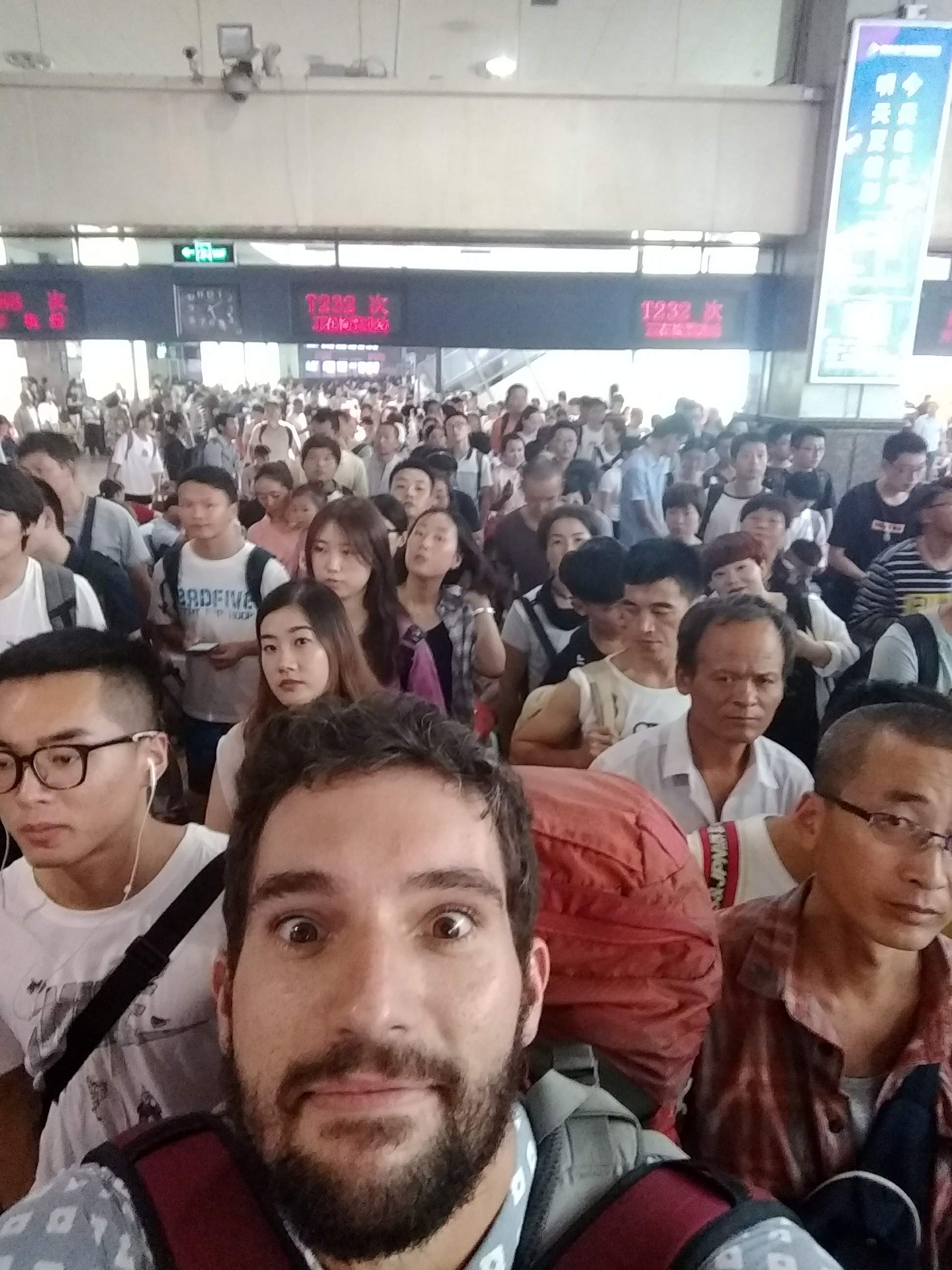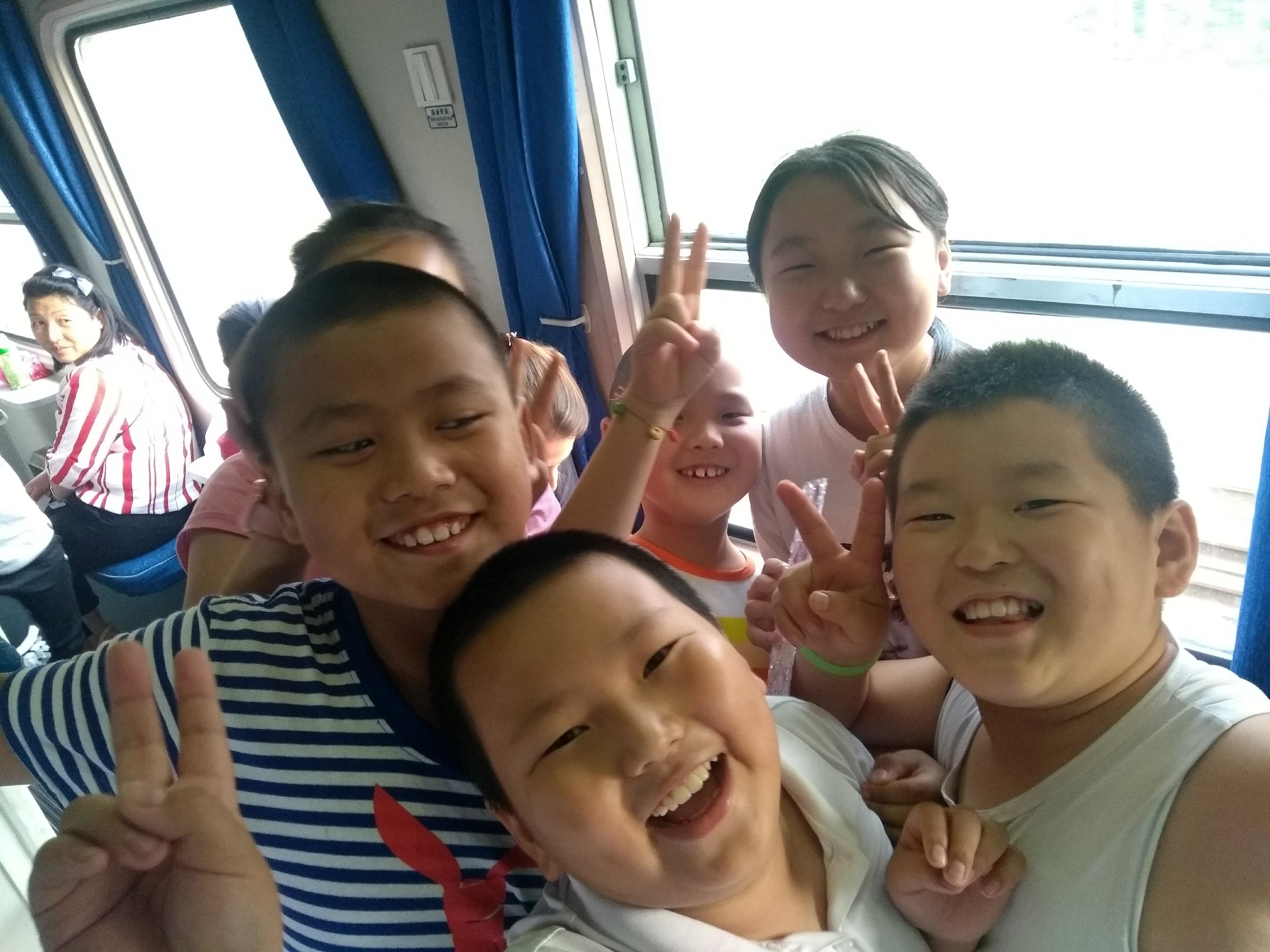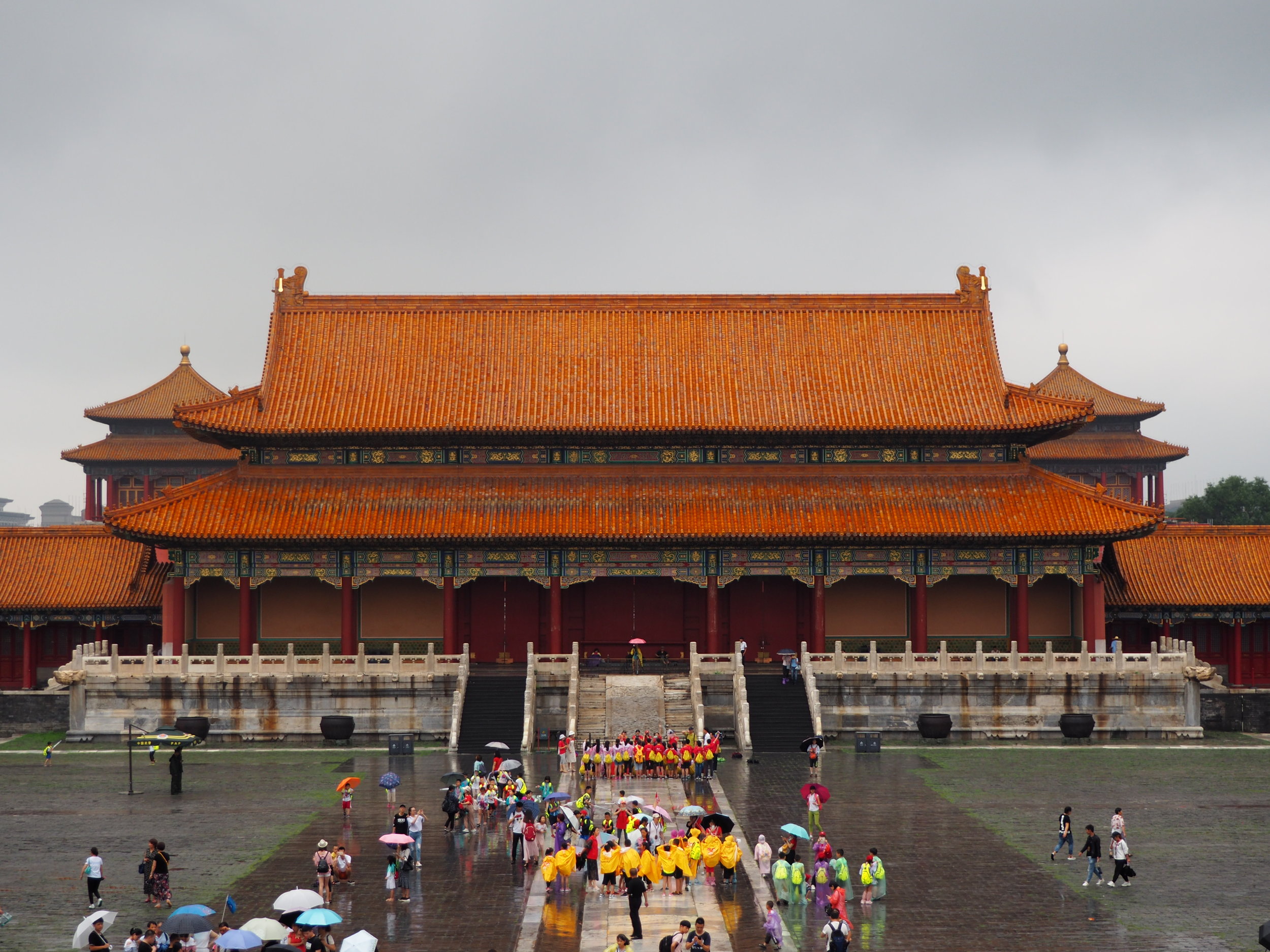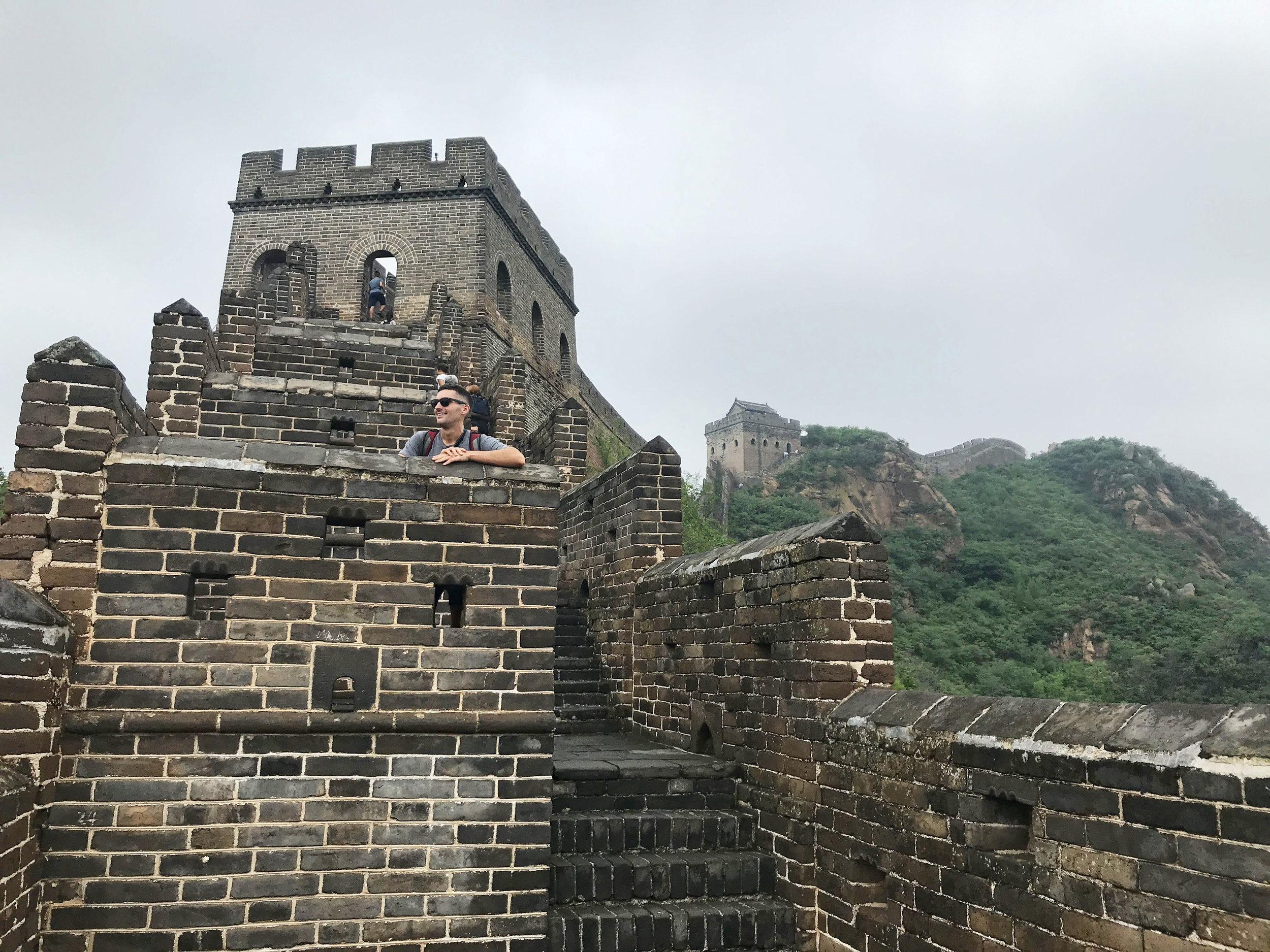With just a week remaining in our China itinerary and some of the country’s biggest sights remaining on the to-see list, Stefje and I boarded a night train in Xi’an with 600 of our closest friends and set off for the 11 hour overnight journey to Beijing.
If it wasn’t apparent from the photo above, we were the only foreigners in sight. For some, this meant their first interaction with a non-Chinese person. We got long stares and gaping jaws from plenty of people on the way to finding our sleeper bunks, but once we settled in the real fun began.
A group of more than 20 children were headed to Beijing on a school field trip, and they proceeded to parade in front of our sleeping area, finding an excuse to cross our path no less than a dozen times before finally gathering the courage to squeal “Hello Sir” and run away.
I was finally able to conduct a brief conversation with one of the children, which proceeded as follows:
Me: “Hello, how are you?”
Him: “Where are you from?”
Me: “America”
Him: “Ohhhh America!” *converses with friends* “Do you like to eat hot dog? Can I take a selfie?”
A relatively restful night bumping on the night train brought us into Beijing as the sun rose, but we weren’t able to check in to our room until the early afternoon, ensuring that we were both absurdly tired by the time we began exploring the monstrosity of a city. With a population of more than 20 million people, Beijing is more than twice as large as the largest American city.
The subway map serves as a good indicator of how expansive the city’s urban center is. Often it would require 3 separate trains to arrive at our destination.
Despite its centuries of history as an important port and the capital city of China, Beijing is a relatively modern city. On our first full day in the city we took 3 metro lines out to the 798 art zone, which offered an absurd juxtaposition of Hello Kitty dolls and communist propaganda.
I even found an old friend, “Great Leader Obamao!”
On our second day in Beijing, we made it out to the Summer Palace, a gorgeous destination built into one of the city’s surrounding hills. Our bodies were drenched in sweat from the combination of humidity and smog before we even began the upward climb, despite the fact that the sun wasn’t in sight for a minute the entire day.
The views from eye level upwards were spectacular: golden curves of pagoda roofs were interspersed with trees to offer a resplendent yet relaxing feeling.
Yet our mid-summers visit also ensured that we shared the grounds of the Summer Palace with dozens of field trips, some of which numbered over a hundred students. The scene was an appalling onslaught of humanity: everywhere we turned, waves of bodies washed around us and it was difficult to find a single spot where we weren’t subjected to being caught in dozens of photos.
It required a surprising amount of mental energy, but there were a few moments where I was able to relax enough to understand what this royal retreat must have felt like hundreds of years ago when it was still in use.
A wide lake was dotted with old-fashioned boats and vibrant lotus flowers, adding an element of calm to the chaos. Yet on the bridge in the distance I could also glimpse hundreds of people, a reminder of how busy it truly was.
By the time Stefje and I explored about a third of the grounds, we were ready and willing to retreat to quieter surroundings.
No exploration of Beijing is complete without a visit to Tiananmen Square and the nearby Forbidden City, so despite the weather threatening with showers, we made our way there. Tiananmen square was intensely guarded by security checkpoints and a plethora of strategically placed guards, all surrounded by an endless expanse of concrete.
We passed under a massive three-doored arch adorned by a extravagant portrait of Chairman Mao to enter the Forbidden city, where intense rains caused everyone to adorn rain gear and umbrellas. The main attraction here for me was the scale of the ancient architecture.
Layers upon layers of intricately hand-carved golden pagoda roofs graced the roof of every building, which is even more impressive when you take into account that the complex is 180 acres large.
We took as many opportunities as possible to venture inwards to the various buildings, which have mostly been converted into museum exhibits but all still house amazing patterned decorations, like this hand-painted ceiling.
After about an hour of walking around in the rain, Stefje and I were sufficiently exhausted by the immensity of the grounds and the overwhelming nature of the crowds, so we found a quiet place to just sit and observe the layers of roofs that sprawled into the distance every way we turned. With the rain pattering above our heads and life moving by all around us, it was a calming ending to the visit and left us feeling in good spirits.
On our last full day in China, we made it to the one attraction that head been at the top of our list since entering the country: The Great Wall of China. To get there we boarded a bus with about a dozen other foreign tourists from our hostel. For the first time while in China, we were surrounded by people who felt like other foreigners and not bombarded by domestic tourists.
The reason for this dramatic shift became apparent as soon as we found ourselves perched above the first of many turrets on the wall. This excursion would require lots of hiking, something Chinese travelers are deeply averse to.
The hike began pleasantly enough. We stared in awe at the long, snaking wall, which expanded far further in the distance than our eyes could see. Our minds were boggled to learn that we were exposed to less than 1% of the entire structure, which was used to repel Mongol invaders and was built, enhanced, and refurbished throughout the Ming Dynasty (1368-1644).
The geographic lay of the land dictated where each turret should lie, and as we explored the various battle positions and surrounding thick forest, it was easy to see how this wall defeated advances for hundreds of years.
Our views from the highest points were just absurd: steep wooden hills slanted off on either side of the topmost points, and the wall slowly dissolved into the distance.
Even though I had officially sweated all the way through my shirt within the first 20 minutes of the walk, Stefje and I were holding strong until the last 3 miles of the day. Suddenly the absurd slopes of the uphill sections began to appear impassable, as though we would slide down with any wrong steps.
The staircases were also difficult to manage: high steps prevented us from walking easily up them, and we were so winded at each of the turrets that we would rest for a bit of shade and to take advantage of the slight breeze which funneled through the castles.
With straining legs and aching backs we made it to the final spot on the wall where we would descend from, but not before taking one look back on the expanse of ground we had covered and the absurdity of the last turret in the distance that we could just barely glimpse. This was out last true view of China, and what a sight it was!




















